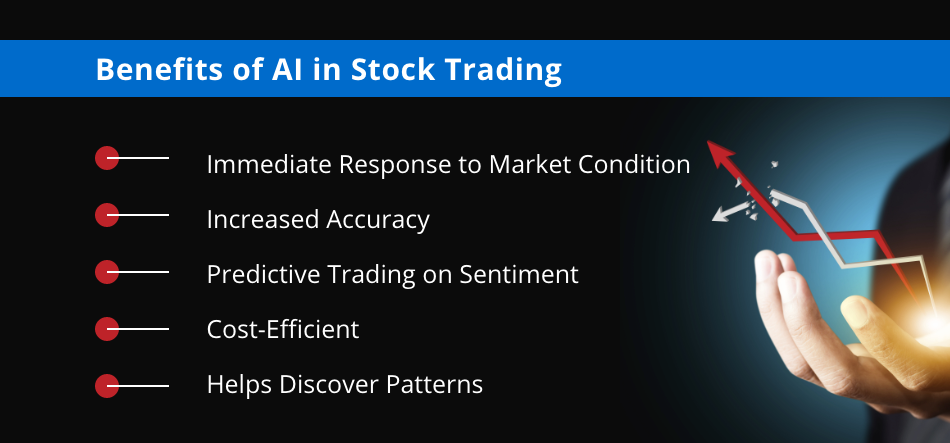20 New Tips On Deciding On AI Stock Predictions Analysis Websites
20 New Tips On Deciding On AI Stock Predictions Analysis Websites
Blog Article
Top 10 Suggestions For Evaluating The User Interface And Experience Of Ai Stock Predicting/Analyzing Trading Platform
User Interfaces as well as the User Experiences are essential for the user-friendliness of an AI trading platforms that predict and analyze stocks. A poorly designed user interface could hinder the decision-making process, even when the AI models that underlie the interface are robust. These are the top 10 guidelines for assessing the UI/UX of these platforms:
1. Examine the ease of use as well as the intuitiveness, simplicity and ease of use.
Navigation: Make it simple to navigate the platform including menus, workflows and buttons.
Learning curve: Measure how quickly an individual can master a system and learn to use it without extensive instruction.
Look for similar designs (e.g. color scheme and button styles) across all platforms.
2. Check Customizability
Dashboard customization: Check if users can personalize dashboards to display relevant data, charts, and metrics.
Layout flexibility: Ensure the platform permits users to rearrange or resize widgets, charts, and tables.
Themes and preferences: Find out whether the platform has dark or light options or other preferences for visuals.
3. Visualize the data with the Assess Tool
Chart quality: Make sure the platform provides high-quality, interactive charts (e.g. candlestick charts, line charts) with zoom and pan functions.
Visual clarity: Make sure the data are presented clearly with labels, legends, and tooltips.
Real-time updates: Verify that the visualizations are updated in real-time, to reflect changes on the market.
4. Test the responsiveness and speed.
Loading speed: Ensure whether the platform is loading quickly, even with massive databases.
Real-time performance: Find out if the platform can manage real-time feeds of data without delay or lag.
Cross-device compatibility : Check if the platform is compatible with all devices (desktops, mobiles, tablets).
5. Examine Accessibility
Look through the mobile application to determine if the app has all of the features you require to conduct business on the move.
Keyboard Shortcuts: Check that your device supports keyboard shortcuts.
Accessibility features: Check whether the platform is compliant with accessibility standards (e.g. screen reader support or high-contrast mode).
6. Utilize the Search and Filter Functions
Search effectiveness: The platform must enable users to search quickly for stocks, indices as well as other investments.
Advanced filters: Determine whether there are filters that could be applied to your results.
Saved searches. Verify the platform's ability to permit users to save frequently-used search terms or filters.
7. Look for Alerts or Notifications
Individually customizable alerts: Users can make alerts that are based on specific conditions, such as price thresholds or spikes in volume and news happenings.
Notification delivery: Make sure that alerts are sent via multiple methods, e.g. SMS, in-app notifications, or email.
Check for promptness and the accuracy of alerts.
8. Evaluation of Integration with Other Tools
Broker integration: Make sure the platform is fully integrated to your broker account in order to facilitate trade execution.
API access: Determine if the platform allows advanced users to create custom tools and workflows.
Third-party interfaces: Check if the platform supports integration with third-party software (e.g. Excel or Google Sheets) and trading robots.
9. Examine Help and Support Features
Tutorials for onboarding Make sure that new users have the ability to access tutorials.
Help center - Ensure that the platform includes a comprehensive support center or knowledgebase.
Customer service: Examine to determine if the platform offers prompt customer service.
10. Test for Overall User Satisfaction
Reviews of user feedback: research reviews and feedback to determine general user satisfaction with the platform's UX/UI.
Free trial period: Use the platform for free and evaluate its usability.
Error handling: Verify how the platform handles edge cases or errors (e.g. insufficient inputs and server downtime).
Bonus Tips
Aesthetics. While practical design is essential but a visually appealing design can enhance user experience.
Performance under stress Test the platform in extreme market volatility to ensure it remains stable and flexible.
Go to the community or forums to see if there is a user group where users can discuss tips and provide feedback.
If you follow these guidelines to evaluate the UI/UX of AI stock predicting/analyzing trading platforms and make sure they're efficient, user-friendly, and suited to your trading needs. A well-designed UI/UX is a powerful tool that can assist you in making more informed decisions and trades. See the top rated options ai for more info including ai for stock predictions, best ai for trading, ai for stock predictions, ai investing app, best ai trading software, using ai to trade stocks, ai investing, ai stocks, ai stock, best ai stock trading bot free and more.
Top 10 Tips For Evaluating The Risk Management Of Ai Stock Forecasting/Analyzing Trading Platforms
A trading platform that utilizes AI to predict/analyze stocks must be equipped with a strong risk management process. This can protect your capital investment and reduce any possible losses. Platforms with robust risk-management tools will help you navigate uncertain markets and make informed decisions. Here are the top 10 ways to evaluate the risk management capabilities of these platforms. capabilities:
1. Check out Stop-Loss and Take Profit Features
Customizable Levels: Be sure the platform allows you to set individual stop-loss levels and take-profit targets for trades or strategies.
Find out if the platform allows for trailing stops. They will automatically adjust themselves as markets shift in your direction.
If the platform has the option of a stop-loss order that guarantees your position is closed to the specified price in markets that are volatile and you are assured of a profitable trade.
2. Assess Position Sizing Tools
Fixed amount: Make sure that the platform you are using allows you to adjust the size of your position according to a fixed amount.
Percentage of portfolio: You can manage your risk by establishing positions sizes in proportion to a percentage.
Risk-reward-ratio: Determine if the platform lets users define their own risk/reward ratios.
3. Make sure you have Diversification Support
Multi-assets trading: Verify that the platform can support trading across a variety of asset classes (e.g. ETFs, stocks options, forex etc.) for diversification of your your portfolio.
Sector allocation: Ensure that the platform includes tools for monitoring the exposure of different sectors.
Geographic diversification: Make sure that the platform you trade on allows international markets to spread risk geographically.
4. Review the margin and leverage controls
Margin requirements - Make sure that the platform explains margin requirements clearly.
Check the platform to see whether it lets you set limits on leverage to limit risk.
Margin calls - Check whether your platform informs you about margin calls promptly. This will help prevent liquidation.
5. Assessment and Reporting of Risk
Risk metrics - Check that your platform contains key risk metrics such as the Sharpe ratio (or Value at Risk (VaR)) or drawdown (or value of the portfolio).
Scenario analysis: Check whether the platform permits users to create various market scenarios in order to evaluate possible risks.
Performance reports: Verify if the platform provides detailed performance reports, including risk-adjusted returns.
6. Check for Real-Time Risk Monitoring
Portfolio monitoring: Ensure your platform provides live monitoring of the risk exposure to your portfolio.
Alerts and notifications: Examine the platform's ability to provide real-time warnings of events that may be risky (e.g. breached margins or Stop losses triggers).
Risk dashboards: Ensure that your platform offers customizable risk dashboards to give you an entire view of your profile.
7. Tests of Backtesting and Stress Evaluation
Stress testing: Make sure the platform allows you to stress test your strategies or portfolio in extreme market conditions.
Backtesting Check to see if your platform supports backtesting using historical data to evaluate the performance and risk.
Monte Carlo simulators: Verify that the platform is using Monte Carlo to simulate a number of possible outcomes so that you can assess risk.
8. Risk Management Regulations - Assess the compliance
Ensure that the platform meets the regulatory compliance requirements (e.g. MiFID II regulations in Europe, Reg T regulations in the U.S.).
Best execution: Check if the platform follows the best execution practices, making sure that transactions are executed at the best prices to avoid the chance of slippage.
Transparency: Check whether the platform offers clear and transparent risk disclosures.
9. Verify that the parameters are controlled by the user.
Custom Risk Rules: Ensure that you have the ability to create custom rules for risk management (e.g. an amount that is the maximum loss per day, or a maximum amount of tradeable position).
Automated risks controls: Verify whether the system can automatically apply rules to manage risk according to the parameters you have set.
Manual overrides: Check whether your platform permits you to manually override automated risk control.
10. Review User Feedback and Case Studies
User reviews: Examine reviews from users to assess the platform's efficiency in risk management.
Testimonials and case studies They will showcase the platform’s risk management capabilities.
Forums for community members Find out if there is an active group of traders who share tips and strategies for managing risk.
Bonus Tips
Trial period: Try the demo or trial version for free to test the platform's risk management features in real-world scenarios.
Customer Support: Verify that the platform can provide comprehensive support for any risk management related questions or issues.
Educational resources - See if the platform has educational resources and tutorials on risk management best practice.
Check out these suggestions to determine the risk-management abilities of AI trading platforms that can predict or analyze the price of stocks. Select a platform that has a high quality of risk-management and you will limit your losses. To make trading successful and manage volatile markets, strong risk management tools are crucial. Take a look at the top rated article source about how to use ai for copyright trading for site examples including best ai penny stocks, ai stock prediction, ai stock investing, ai stock trader, ai trading tool, ai stock analysis, free ai tool for stock market india, can ai predict stock market, best ai for stock trading, ai stock investing and more.